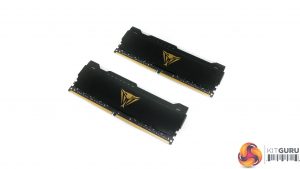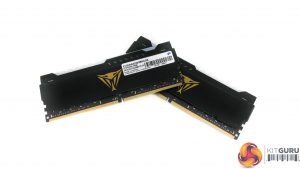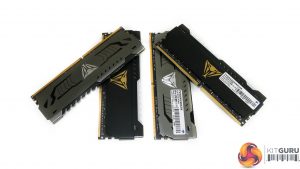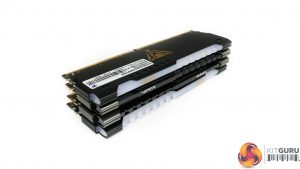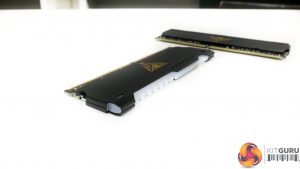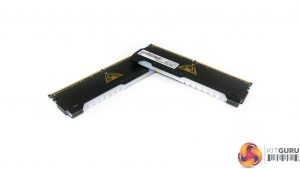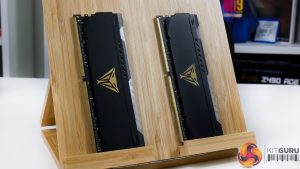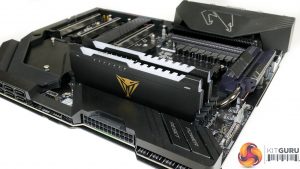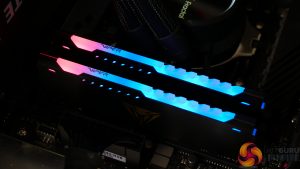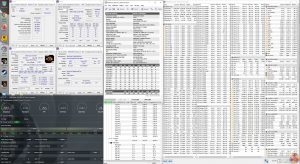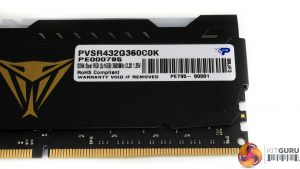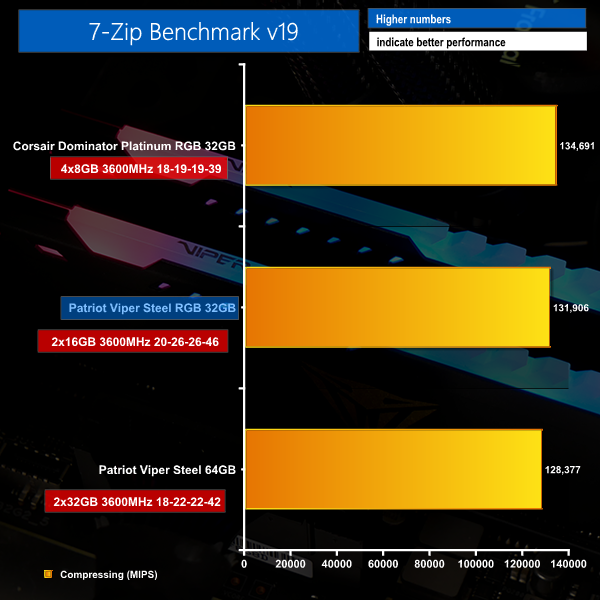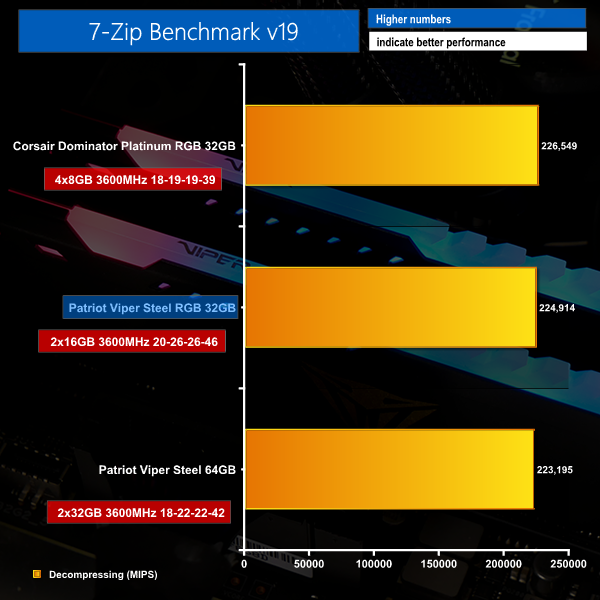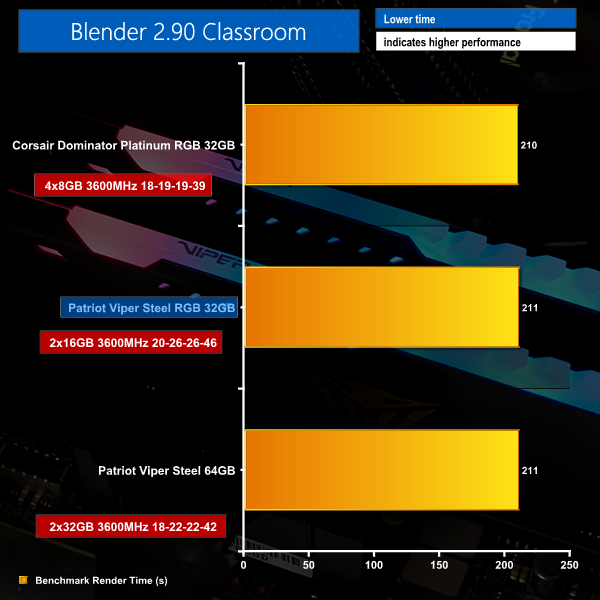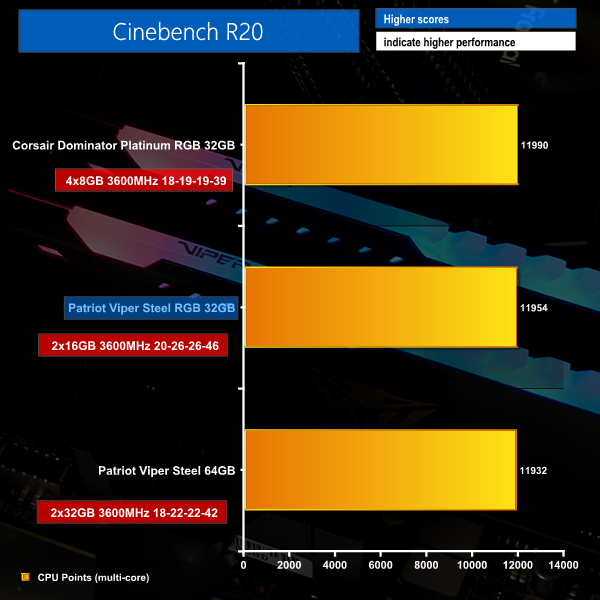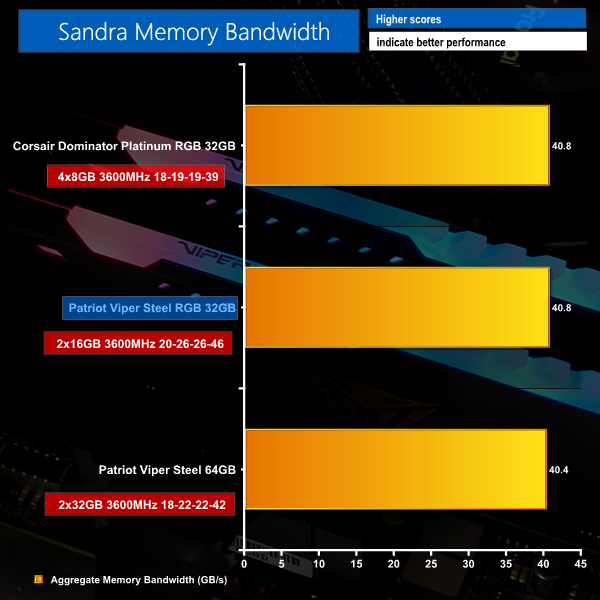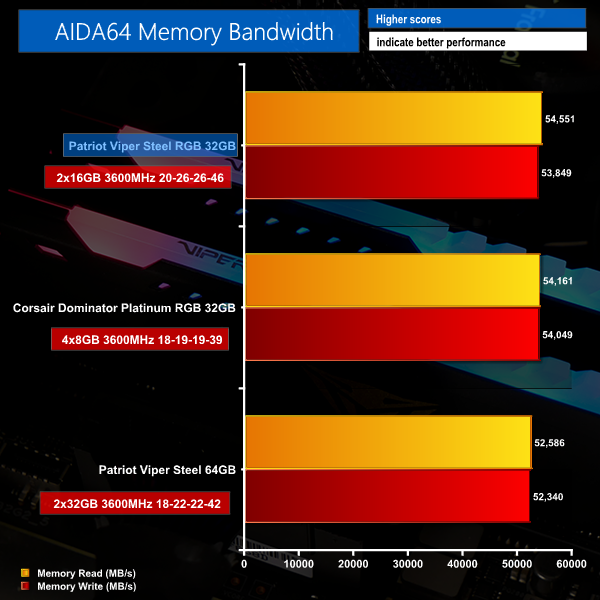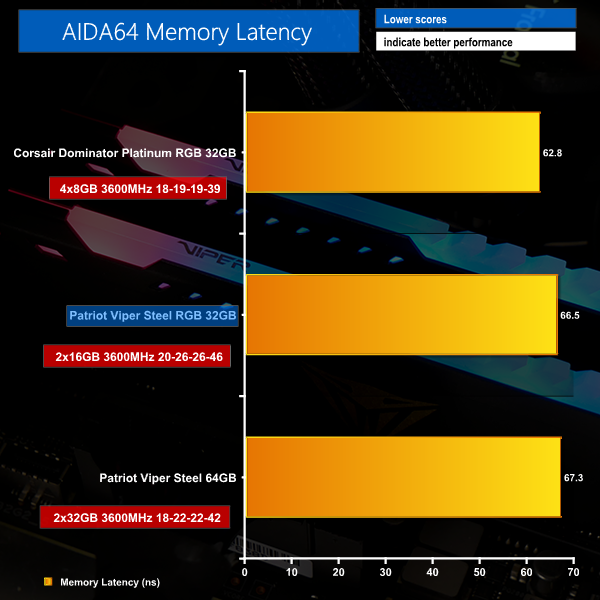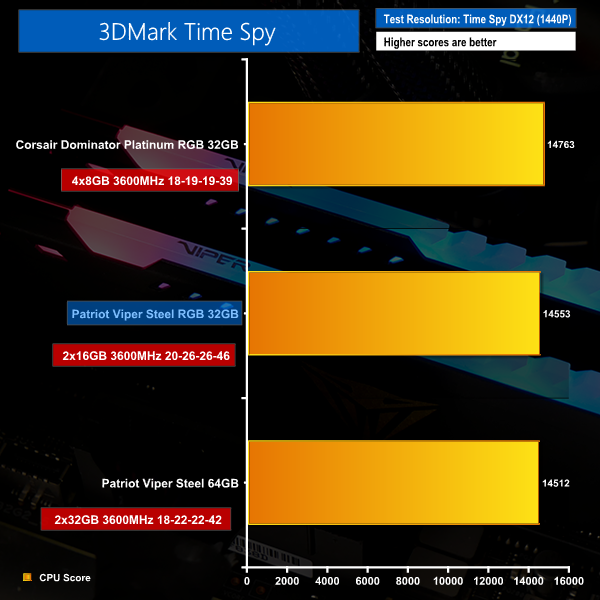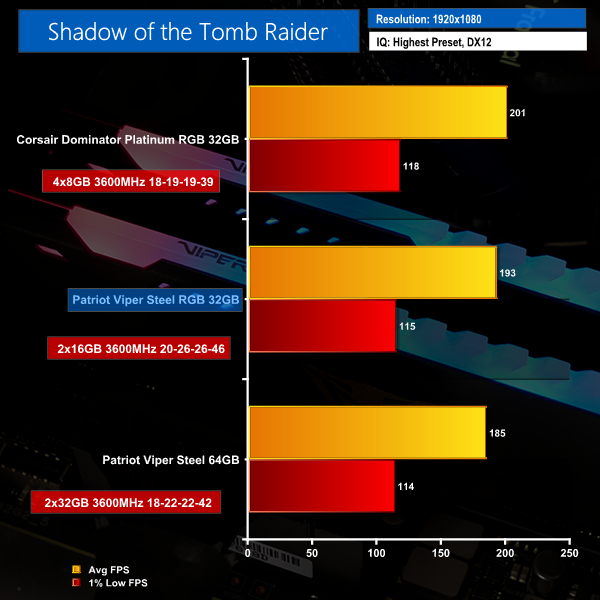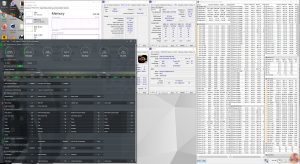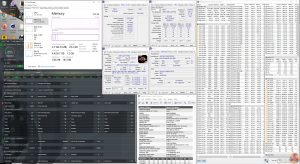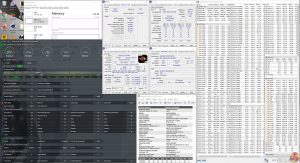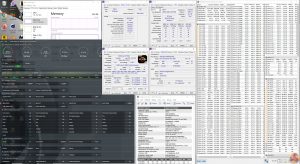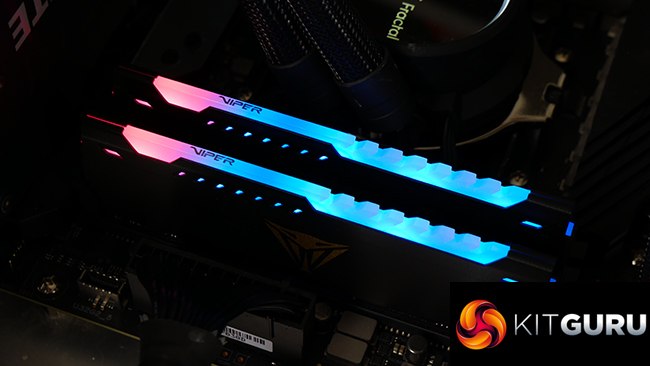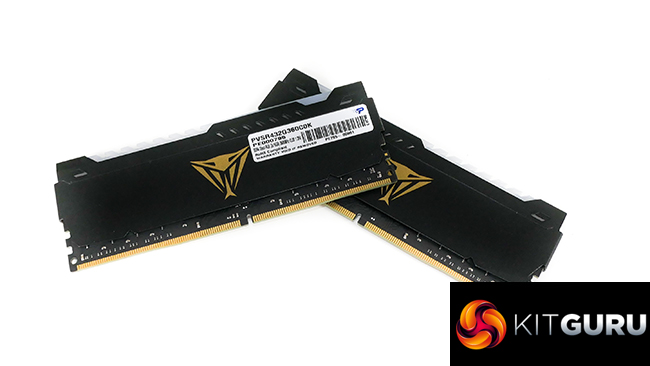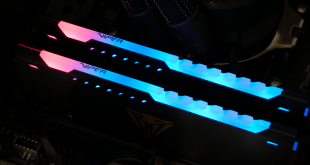
Patriot is upgrading its popular Viper Steel series of memory to include RGB lighting, as is seemingly expected from every PC component in 2021. Featuring a black aluminium heatspreader with a top-mounted set of RGB LEDs and a diffuser lightbar, can the Patriot Viper Steel RGB memory prove to be a solid new option to the market?
The Patriot Viper Steel RGB memory module follows the same no-nonsense design logic of the standard non-RGB version of the RAM. Now, however, the aluminium heatspreader has been switched to a matte appearance with a grain-type texture while the Viper logo is coloured gold.
While the ‘Steel’ naming scheme now makes less sense given the black appearance, I personally feel that these styling adjustments are a good transition in creating a more attractive memory module. The black heatspreader looks sleek alongside the black PCB and, of course, retains it cooling functionality given the use of aluminium material.
Across the top of the roughly 48mm-tall memory module sits the RGB lightbar. This retains the aggressive angular styling of the non-RGB Viper Steel modules, but the height is now around 3mm taller for the LED-equipped kit.
It is difficult to tell exactly how many RGB LEDs sit underneath the lightbar. And that is a particularly important point given the perceived smoothness of the emitted light. Similarities to the light diffuser strip on the Corsair Vengeance RGB Pro modules are evident, and that’s strong praise for Patriot.
Lighting control is handled through the sync utilities of the big four motherboard vendors. We tested with ASUS AURA and found the functionality to be straightforward and effective. The lighting speed is good, the brightness is positive, and the granularity of control is solid.
Colour accuracy for the lightbar is also positive overall, though we did notice that our white colour selection displayed a slightly off-white tint. Other than that, I was also happy with the transitions between colours in the go-to RGB rainbow puke mode.
In terms of modules specs, Patriot offers a variety of options. The kit that we have for testing is a 32GB (2x16GB) capacity set with rated specifications of 3600MHz at 20-26-26-46 timings and 1.35V. Of course, XMP 2.0 is supported.
Those timings are incredibly slack for a modern 3600MHz dual channel memory kit, so it will be interesting to see if we are able to overclock to some tighter numbers. Of course, 3600MHz is still ideal for simple 1:1 memory controller to Infinity Fabric clock operation on AMD platforms. And any additional frequency through overclocking will be welcomed by Ryzen 5000 users with higher FCLK capabilities.
The specific memory chips used read as Hynix H5AN8G8N??R-VKC according to Thaiphoon Burner. That pair of question marks makes it unclear, but our contacts at Patriot confirmed that the kit uses SK Hynix “AFR” memory ICs with model code H5AN8G8NAFR-VKC. Those chips are deployed in a dual-rank configuration for each of the 16GB DIMMs.
Worth noting is that neither monitoring software such as HWiNFO nor Thaiphoon Burner could register any thermal sensor data on our test system.
In summary, we are looking at the Viper RGB Steel as a 32GB kit with a solid RGB implementation, 3600MHz running frequency and slack timings, and a price tag of £164.99 MSRP. Let’s have a look at how Patriot’s new set of memory performs.
- Model Number: PVSR432G360C0K
- Capacity: 32GB (2x 16GB)
- Rated Frequency: DDR4-3600MHz
- Rated Timings: 20-26-26-46
- Voltage: 1.35V
- Format: Non-ECC Unbuffered 288-pin DIMM
We will be outlining the Patriot Viper Steel RGB Series DDR4 memory’s performance with the AMD Ryzen 9 5950X CPU, ASUS ROG Crosshair VIII Hero motherboard, and a Gigabyte RTX 3080 Eagle OC graphics card.
The processor is overclocked to a static 4.6GHz to take any clock speed variability from Precision Boost 2 out of the performance equation.
Test System:
- Processor: AMD Ryzen 9 5950X overclocked to 4.6GHz all core.
- Motherboard: ASUS ROG Crosshair VIII Hero.
- Graphics Card: Gigabyte RTX 3080 Eagle OC.
- System Drive: WD_Black SN750 SSD.
- CPU Cooler: Fractal Celsius+ S28 Prisma 280mm AIO.
- Power Supply: Seasonic Prime TX-1000 1000W.
- Case: Lian Li Open-air Test Bench.
- Operating System: Windows 10 Pro 64-bit.
Comparison Memory Kits:
- 4x8GB Corsair Dominator Platinum RGB (White) 3600MHz 18-19-19-39 (Micron E-die ICs)
- 2x32GB Patriot Viper Steel 3600MHz 18-22-22-42 (SpecTek MT40 ICs)
Tests:
- 7-Zip – Built-in 7-Zip benchmark test (CPU & Memory)
- Cinebench R20 – All-core & single-core CPU benchmark (CPU & Memory)
- Blender 2.90 – All-core rendering of the Classroom benchmark (CPU & Memory)
- SiSoft Sandra – Memory bandwidth (Memory)
- AIDA64 – Memory bandwidth, memory latency (Memory)
- 3DMark TimeSpy – Time Spy (1440p) test (Gaming)
- Shadow of the Tomb Raider – 1920 x 1080, Highest quality preset, no AA, DX12 version (Gaming)
Compute and Productivity Tests
We see a reasonable start for the Viper Steel RGB memory kit in 7-Zip. Middle-of-the-pack scores are registered both in terms of compressing and decompressing. Blender, however, shows very little variance between each tested kit. The Patriot Viper Steel modules cannot quite match the performance of Corsair’s expensive Micron E-die kit, but the differences are minor.
In Cinebench, we again see the SK Hynix-based Viper Steel RGB modules slightly outperforming the higher-capacity, SpecTek-based non-RGB kit. Corsair’s tighter Micron kit is again at the top of the chart by a narrow margin, though.
Memory Benchmarks
Synthetic memory bandwidth tests show very little difference between Patriot’s Viper Steel RGB modules and the premium Corsair Dominator Platinum options in our testing. The SpecTek-based Viper Steel 64GB kit is again a little slower than the SK Hynix-based RGB version though, despite having tighter rated timings and a higher kit capacity.
Latency is where the performance of Patriot’s RGB kit cannot match the premium Corsair modules. But once again, we see the SK Hynix-based RGB kit outperforming the SpecTek modules of the non-RGB Viper Steel set despite the LED version having looser timings on paper.
Gaming Tests
It’s more of the same in gaming-related tasks. The Viper Steel RGB is marginally quicker than the technically tighter 64GB SpecTek-equipped kit, but Corsair’s more expensive modules are tough to match.
In real world gaming, that translates into higher FPS for the Corsair Micron-based kit. But the Hynix ICs for the Viper Steel RGB memory do a reasonable job and manage to outperform the SpecTek-based 64GB Viper Steel kit once again.
Overclocking
Overclocking actually presented us with a reasonable amount of success even when accounting for the particularly loose stock XMP timings.
Focusing on increasing the frequency whilst maintaining the stock 20-26-26-46 timings, we managed to get as high as 4066MHz with 1.45V. This is a pretty good result in our opinion but obviously we still have the slack timings.
Switching focus to tightening the timings while at the stock 3600MHz frequency, we got as tight as 16-18-18-46 with 1.45V. Again, this is a reasonable result and manages to match some of the more premium 3600MHz kits on the market, albeit with the luck of the silicon lottery and a high voltage used.
Aiming for a balance between frequency and timings, we managed 4000MHz 18-22-22-46 at 1.45V with a frequency bias. And with a timings bias, we hit 3800MHz 16-20-20-46 at 1.45V.
That 3800MHz CL16 result was particularly positive in our opinion as it allowed a 1:1 divider to run with a 1900MHz Fabric clock on our overclocked Ryzen 9 5950X CPU.
Overall, the stock timings are lacklustre for the 3600MHz frequency. But the pair of 16GB DIMMs overclock to some solid settings when a little effort and 1.45V DRAM voltage are applied. 3800MHz CL16 with 1900MHz Fabric clock is reasonable outcome for our testing.
The Viper Steel RGB memory kit is a good addition to Patriot’s Viper Gaming series memory line. You get an aesthetically pleasing design with a good RGB lightbar implementation.
I am actually quite positive overall on the RGB lighting implementation. In my opinion, the colour accuracy is good – with the exception of a clear white – and the lighting uniformity is respectable given the angular lightbar implementation. Personally, the fact that the lightbar is reasonably sized and not overpowering adds to the quality of styling for the Viper Steel RGB modules. But, of course, that is my own personal taste.
The kit worked fine with ASUS AURA RGB software and had no trouble managing a variety of lighting modes and flashing speeds. Of course, the design and implementation of the RGB lighting will be down to individual preference. However, I can see clear comparisons to Corsair’s Vengeance RGB Pro memory modules, and that is reasonable praise for Patriot.
Undeniable, however, is that stock performance leaves a little to be desired given the incredibly slack timings for a 3600MHz 2x16GB kit. 20-26-26-46 really is quite slow indeed, especially as the kit uses respectable Hynix AFR memory ICs rather than budget brand alternatives.
We did manage to overclock successfully past 4GHz with tightened timings, or to 3800MHz running CL16. This used 1.45V, so is not directly comparable to many 1.35V XMP kits on sale. However, it does imply that there is solid headroom available from the Hynix ICs based on our test kit.
The performance from the Hynix ICs in a dual-rank configuration allowed the Viper Steel RGB kit to outperform the standard Viper Steel SpecTek-based 64GB kit on our test system. However, Micron E-die-based modules at a marginally higher price point – such as Crucial’s Ballistix that can offer around 3600MHz CL16 to CL18 – will tend to perform better. And you should not expect Samsung B-die levels of latency tightening performance either.
Pricing looks to be a sticking point at the moment for the Viper Steel RGB kit, though. At £164.99 MSRP, the 2x16GB 3600MHz 20-26-26-46 kit from Patriot is going up against 3600MHz RGB kits from pretty much all other vendors including Corsair, Kingston, G.SKILL, TeamGroup, KLEVV, and ADATA. In fact, many of those aforementioned vendors have their 3600MHz CL18 32GB kits on sale for around £10-20 cheaper at UK e-tailers. Corsair’s Vengeance RGB Pro, for example, which is 2x16GB 3600MHz 18-22-22-42 retails at £149.99 and that is a tough contender for Patriot’s £164.99 looser latency modules to fight against.
Current MSRP pricing looks to be on the high side, but it will be important to see if UK retailers make Patriot’s Viper Steel RGB modules available for a similar price point to the competition. If the current US price point of $155 is anything to go buy, Patriot’s Viper Steel RGB modules will slightly undercut the primary competition and this will make up for the slacker timings. If that is the case, the Viper Steel RGB kit will can be worthy of shortlisting.
Overall, Patriot has done a good job with the RGB implementation of the Viper Steel RGB modules. The matte black aluminium heatspreader looks great and it nicely compliments the well-built RGB LED lightbar. The stock timings are lacklustre; however, the overclocking performance was more positive than we expected for the Hynix AFR ICs on our kit.
We don't yet have a buy link for this kit but have been told the UK MSRP is £164.99.
Discuss on our Facebook page HERE.
Pros:
- Sleek aesthetic design.
- Good RGB LED brightness and smoothness through the lightbar.
- Solid overclocking performance for our kit.
- Reasonable module dimensions – not too overpowering.
- Aluminium heatspreader should aid module cooling.
Cons:
- Very loose out of the box XMP timings.
- MSRP will give stiff competition versus tighter latency kits.
KitGuru says: A sleek design with a good, no-nonsense RGB implementation and solid overclocking capability. Let's hope that the UK street price allows Patriot's Viper Steel RGB modules to be competitive in light of the slack XMP timings.
Be sure to check out our sponsors store EKWB here
 KitGuru KitGuru.net – Tech News | Hardware News | Hardware Reviews | IOS | Mobile | Gaming | Graphics Cards
KitGuru KitGuru.net – Tech News | Hardware News | Hardware Reviews | IOS | Mobile | Gaming | Graphics Cards


